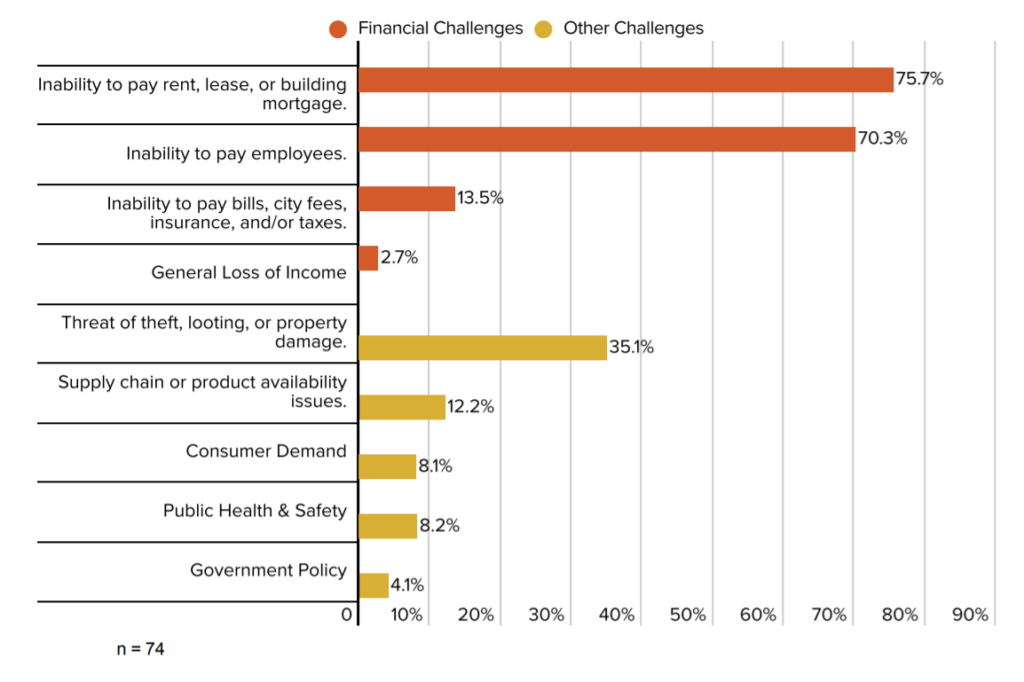Downtown survey shows small window for many businesses to reopen and recover
Wednesday, April 29, 2020 by
Chad Swiatecki A large majority of business storefronts in downtown Austin are at risk of closure in the next two to three months without significant increases in commercial activity, according to a new study on the effects of the Covid-19 pandemic.
The Downtown Austin Alliance released the results Tuesday of a recent survey of 80 downtown business owners examining how deeply they have been impacted by the pandemic and the restrictions on nonessential business activity since mid-March. One of the most significant findings was that 80.5 percent of respondents said they could survive three months or less of closure or restricted activity, with the report’s summary noting that “restaurants, bars, performance venues, and event businesses are at greater risk of closing” in the short term. And 20.8 percent of respondents said their survival window was one month or less from the time of the data collection earlier this month.

Retail, professional services and nonprofit organizations had slightly better prospects, with more of them reporting they could reopen even after four or more months of closure.
With foot traffic along downtown’s main artery of Congress Avenue estimated to have dropped off nearly 90 percent since the city and state implemented shelter-at-home and other restrictions, 62.5 percent of businesses in the downtown core have closed temporarily, with 2.5 percent deciding to close for good. The remaining 35 percent have stayed open by adapting their business models with combinations of online commerce for retail, delivery or takeout service for restaurants, and remote working for professional office jobs.
Dewitt Peart, president and CEO of the downtown alliance, said severe hits to annual revenue for all downtown businesses and uncertainty from the public about health implications of resuming normal daily activities create an uncertain future for the downtown economy.
“There still remains a lot of uncertainty, and in the conversations we have and the comments that came through in the survey there is a fair amount of uncertainty, so the future is a big unknown,” he said. “As we’re seeing complete closures of a number of the businesses downtown, the bars and music venues … it is going to be a while before they recover and it’s going to be a challenge to adapt those operations. That’s a second piece of this – that not every retail establishment or venue has the same path to adapting or recovering. It’s not one solution fits all. We’re seeing tremendous amounts of lost revenue and that is going to continue for the near future.”

Peart, who is a member of a recently convened task force charged with planning for the gradual reopening of businesses throughout Central Texas, said he expects it will take several weeks before customers return to downtown in large numbers after the state’s restrictions on business activity expire on Friday. Those guidelines call for restaurants, retail stores and movie theaters to open as normal but with 25 percent of their usual capacity.
“We are anxious to see what the consumer confidence is with these businesses open and what the traffic looks like,” he said. “Obviously for retail businesses, pedestrian traffic is the lifeblood. We are not fully sure how this reopening of businesses in Texas will play out.”
The downtown alliance is also conducting surveys of the area’s property owners and downtown residents to get a fuller picture of how the pandemic has affected life and business. He said the retail survey is likely to be conducted again to gauge progress in the business recovery, which will help the group advocate for public assistance in the form of loans and grants, along with marketing efforts to gradually convince more people that they can shop and eat out safely.
“Our role as we see it going forward will be focused on initiatives like this, where we pursue the research and understanding of the underlying challenges so we can communicate those issues, advocate on behalf of those businesses, help educate the businesses and their customers, and more broadly market because we are going to need to have an intense marketing effort.”
Photo made available through a Creative Commons license.
The Austin Monitor’s work is made possible by donations from the community. Though our reporting covers donors from time to time, we are careful to keep business and editorial efforts separate while maintaining transparency. A complete list of donors is available here, and our code of ethics is explained here.
You're a community leader
And we’re honored you look to us for serious, in-depth news. You know a strong community needs local and dedicated watchdog reporting. We’re here for you and that won’t change. Now will you take the powerful next step and support our nonprofit news organization?











